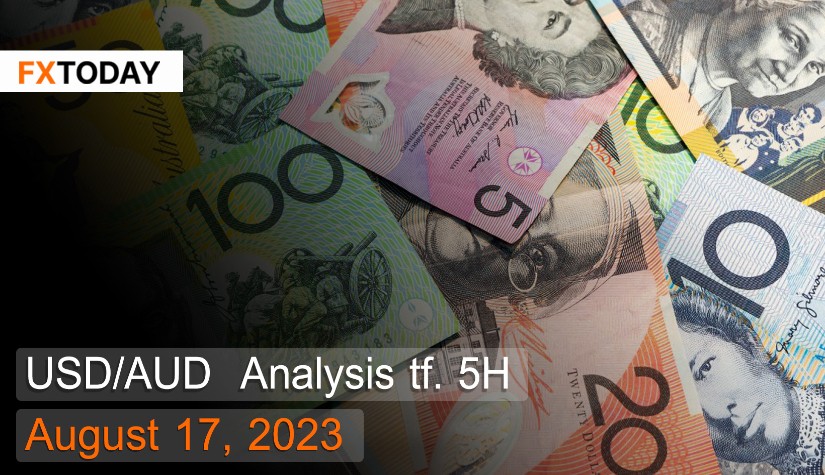Australia continues to face domestic issues.
The Australian dollar has continued to weaken steadily and reached another nine-month low due to less favorable domestic economic indicators. Investors must also closely monitor economic data from China, a crucial trading partner that accounts for over 30% of Australia's exports. China's economy has been experiencing a slower growth rate, affecting its trade relationships, while another country of concern is Japan. Japan's recent data reveals a decline in both imports and exports.
The Australian Bureau of Statistics (ABS) has revealed that Australia's unemployment rate increased to 3.7% in July from 3.5% the previous month, surpassing the market's 3.6% prediction. The number of unemployed individuals rose by 35,600 to a total of 541,000. Furthermore, the demand for both full-time and part-time employment increased by 349,500 and 191,500 individuals, respectively. This data contrasts with a rapid decrease of 14,600 in hiring, largely attributed to increased costs from the previous interest rate hike.
Meanwhile, Australia's wage price index rose by 3.6% YoY in the second quarter. Private sector wages increased by 3.7%, and public sector wages by 3.1%. However, the decrease in hiring has led to a total increase of 4 million hours per month in total working hours across all jobs.
Justin Smirk, the senior economist at Westpac, stated, "The ongoing monetary inflation debate has led to a continuous increase in wages, and this perpetual spiral of wage-price growth is a challenging phenomenon. We must remain open to the idea that wage inflation rates might rise at a slower pace than initially anticipated due to upcoming interest rate adjustments, impacting all sectors."
The 3-year government bond yield rate of Australia has been adjusted downward by 5 basis points (bps) to 3.913%, while the 10-year yield rate has seen an increase of 4.272%. This stands in comparison to the previous month's increase of 30.1 bps. This increase in yields is due to the anticipation that the Reserve Bank of Australia (RBA) will raise interest rates to 4.35% in the coming months.
Techical analysis data (5H)
Resistance: 1.5649, 1.5677, 1.5731
Support: 1.5568, 1.5515, 1.5487
Source: Investing.com
| Name | S3 | S2 | S1 | Pivot Points | R1 | R2 | R3 |
| Classic | 1.5487 | 1.5515 | 1.5568 | 1.5596 | 1.5649 | 1.5677 | 1.5731 |
| Fibonacci | 1.5515 | 1.5546 | 1.5565 | 1.5596 | 1.5627 | 1.5646 | 1.5677 |
| Camarilla | 1.5599 | 1.5606 | 1.5614 | 1.5596 | 1.5629 | 1.5636 | 1.5644 |
| Woodie's | 1.5499 | 1.5521 | 1.5580 | 1.5602 | 1.5661 | 1.5683 | 1.5743 |
| DeMark's | - | - | 1.5582 | 1.5603 | 1.5663 | - | - |
Buy/Long 1: If the price touches the support range around 1.5515 - 1.5568 but fails to break the resistance at 1.5568, consider setting a TP around 1.5677 and a SL at approximately 1.5487 or according to your acceptable risk level.
Buy/Long 2: If you manage to break the resistance zone between 1.5649 - 1.5677, you might want to set a TP around 1.5731 and an SL at approximately 1.5515 or according to your acceptable risk level.
Sell/Short 1: If the price touches the resistance range around 1.5649 - 1.5677 but can't break the resistance at 1.5649, consider setting a TP around 1.5515 and an SL at approximately 1.5731 or according to your acceptable risk level.
Sell/Short 2: If you successfully break the support range between 1.5515 - 1.5568, you might consider setting a TP around 1.5487 and an SL at approximately 1.5677 or according to your acceptable risk level.
| Name | Value | Action |
| RSI(14) | 72.751 | Buy |
| STOCH(9,6) | 57.825 | Buy |
| STOCHRSI(14) | 100.000 | Overbought |
| MACD(12,26) | 0.007 | Buy |
| ADX(14) | 46.520 | Buy |
| Williams %R | -13.717 | Overbought |
| CCI(14) | 226.4152 | Overbought |
| ATR(14) | 0.0083 | High Volatility |
| Highs/Lows(14) | 0.0134 | Buy |
| Ultimate Oscillator | 56.748 | Buy |
| ROC | 1.712 | Buy |
| Bull/Bear Power(13) | 0.0300 | Buy |
|
Buy:8 Sell:0 Neutral:0 Summary:Strong Buy |
||
















